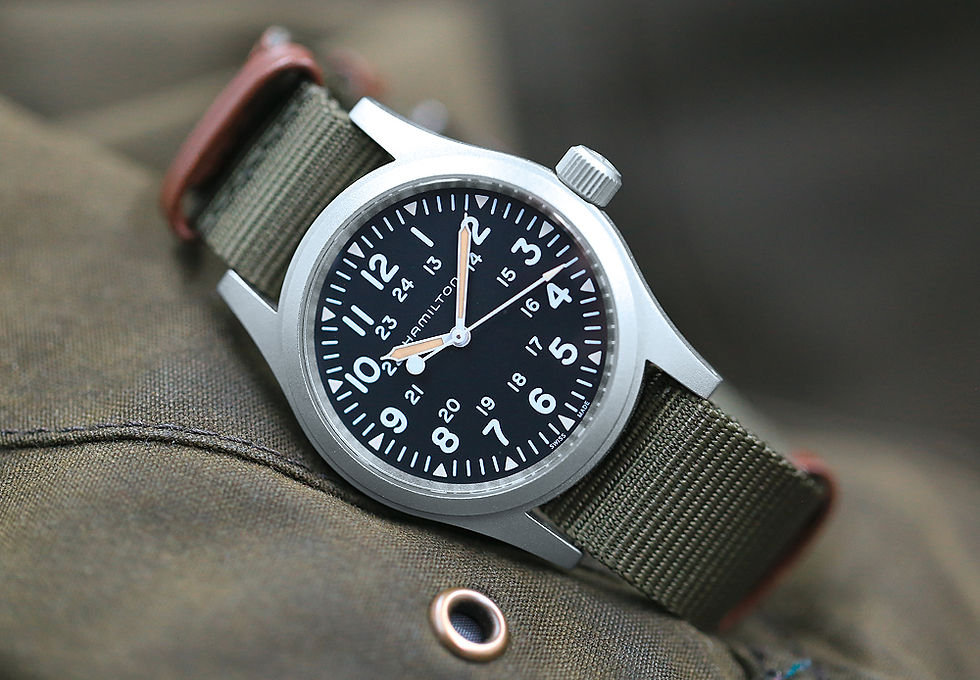Horology, part 1 - The History of Field Watches
- Vinicius A. C. Mauro

- Oct 19, 2021
- 3 min read
Updated: Jun 14, 2025
If you want to jump directly to our list of best field watches to buy click here! If not, here comes a history lesson.
The rhythmic cadence of a watch has been a steadfast companion to explorers, soldiers, and adventurers for centuries. Among the various types of timepieces that have graced wrists over the years, none exudes the rugged charm and utilitarian spirit quite like the field watch.
The origins of the field watch can be traced back to the 19th century, a time of burgeoning industrialization and expansion. As the world underwent rapid changes, so did the needs of those on the move. Pocket watches, the standard of the era, were impractical for outdoor activities and lacked the durability required for rigorous use.
A Wrist-Worn Revolution
Enter the "trench watch." This early precursor to the field watch was born out of necessity during World War I. Soldiers required a timepiece that was easily accessible and could withstand the harsh conditions of the trenches. Manufacturers began producing wristwatches with shrapnel guards and luminous dials, setting the stage for the emergence of the field watch as a distinct category.
World War II marked a pivotal moment in the evolution of field watches. Military forces recognized the importance of reliable timekeeping in combat, leading to the issuance of standardized watches to soldiers. Even though different models were produced during that period, they all shared a few characteristics: they had to be resistant, reliable, and easy to read. Due to wartime conditions, materials like brass, chrome-plated brass, or various alloys were used in most cases, instead of stainless steel. The standard straps were adjustable and made of leather or canvas.
Here are a few iconic models from that period:
The A-11
In 1941, American watch manufacturers Bulova, Elgin, and Waltham launched the A-11 watch. Measuring typically at 32mm, it had a dependable manual wind movement with hacking capabilities. The watch had an outer minute track with 10-minute demarcations, and its black dial boasted luminous markers and hands, making it easy to read even in low-lighting conditions.
British A.T.P Field Watch
The A.T.P. (Army Trade Pattern) was the go-to watch of the British Infantry. At least 17 Swiss manufacturers helped produce it, so they didn't all look exactly the same. However, most of them had a watch case from 30 to about 34mm, silver or white dial with black numerals, small seconds, lume, and fixed bars.
British W.W.W. "Dirty Dozen"
As World War II was nearing its end, the British made significant improvements to the A.T.P. watch. The updated version boasted better water resistance, improved precision, and increased durability. The model was produced by twelve different watch manufacturers, including renowned companies such as Omega, Longines, and Jaeger-LeCoultre. These watches, collectively known as the "Dirty Dozen," hold immense value among collectors due to their historical significance.
German Dientuhr Service Watch
During World War II, the German military, known as the Wehrmacht, issued a standard service watch called the Dientuhr. These watches were produced by various German and Swiss companies and had similar style and specifications to the timepieces used by American and British military forces.
Japanese Seikosha Field
This crucial timekeeping tool for Japanese forces was manufactured by Seiko and looked quite different from other field watches of the era, despite having similar specs. They were smaller, at 30mm, and had white dials with larger numerals.

Civilian Adoption
After the war, the field watch transcended its military origins and found favor with civilians. This led many brands worldwide to seize the opportunity by releasing new models under the category in the 50s and 60s, increasing and solidifying its relevancy. Here are a few examples:
Hamilton Khaki Field
Bulova MIL-W-3818A
Smiths W10
Zenith S.58

In the following decades, the industry witnessed many technological developments that led field watches to expand their capabilities, like the Quartz revolution and the introduction of digital displays. This propelled the creation of new models that quickly became classics, such as the Casio G-Shock DW-5000C, launched in 1983.
The evolution continued. Advancements in manufacturing techniques allowed the creation of even more durable and lightweight watches using materials like titanium, ceramic, and carbon fiber. There were also relevant improvements in water resistance, lume duration, and movement robustness.
Conclusion
The field watches of today remain a symbol of exploration and adventure. More importantly, despite the many novelties that were incorporated, they are still faithful to their origins as resistant, reliable, and useful tools.
For more watch content visit us at our Instagram profile @the_poor_horologist and don't forget to check our top field watches to buy under $500 post


Comments